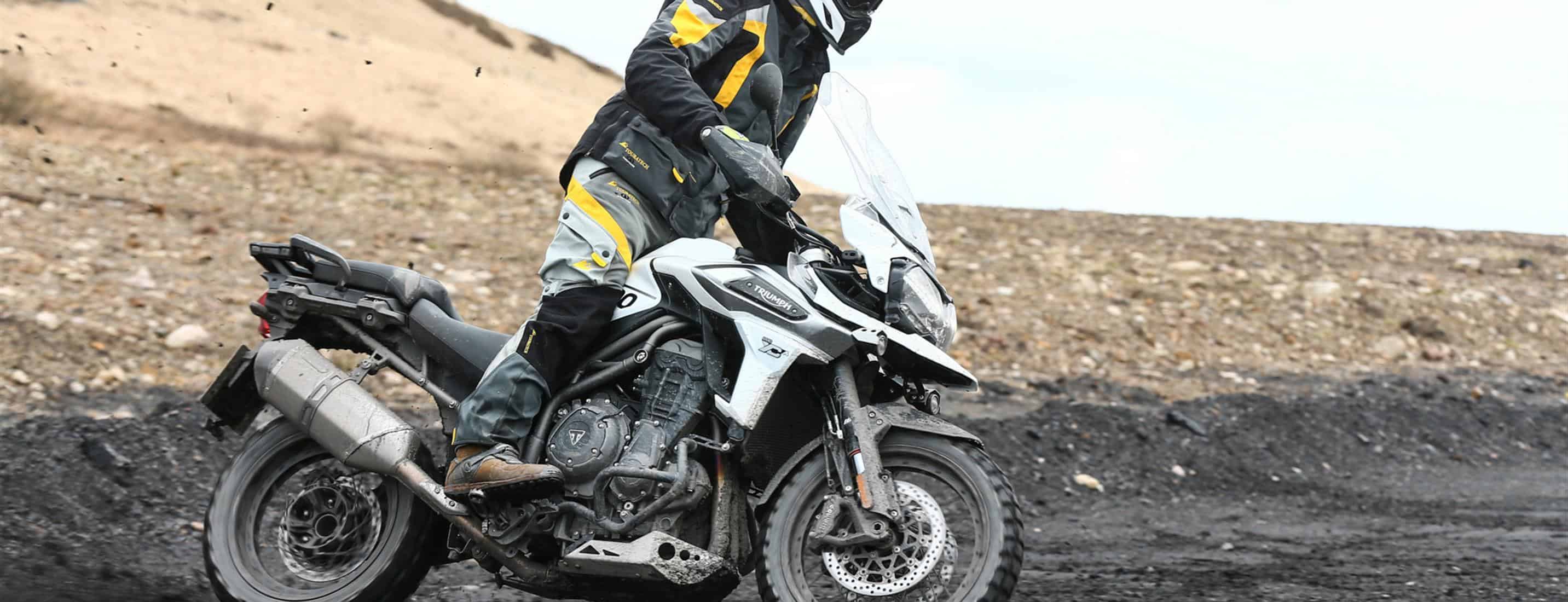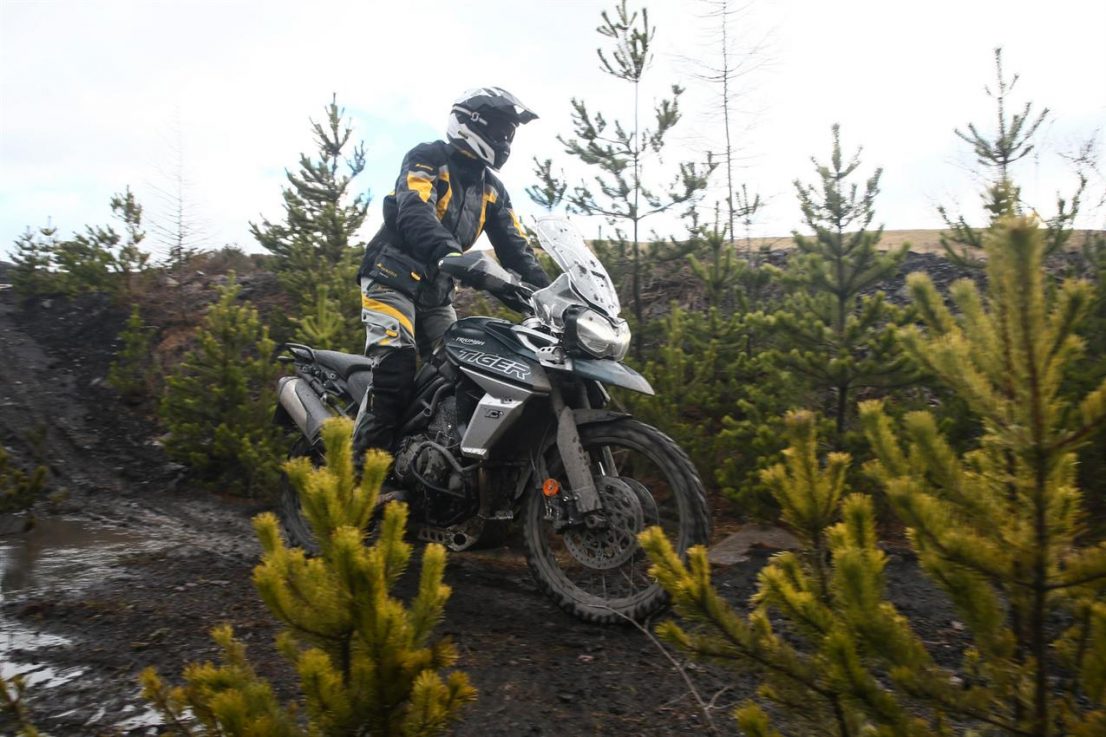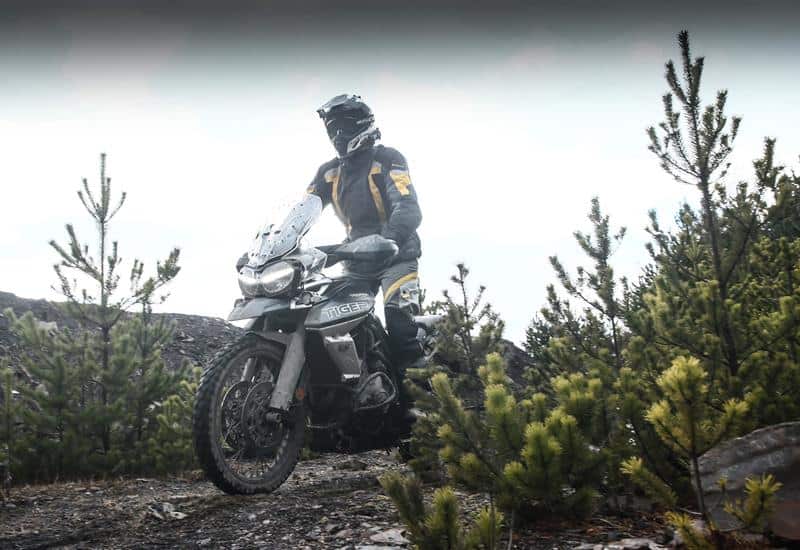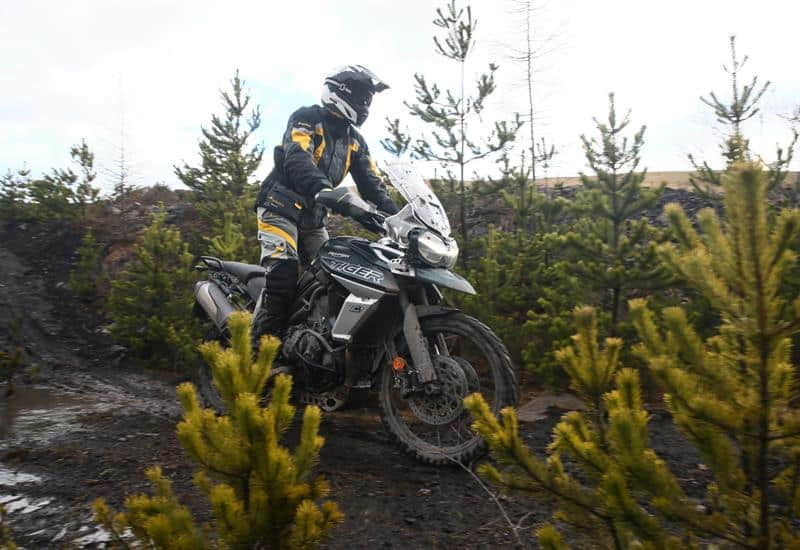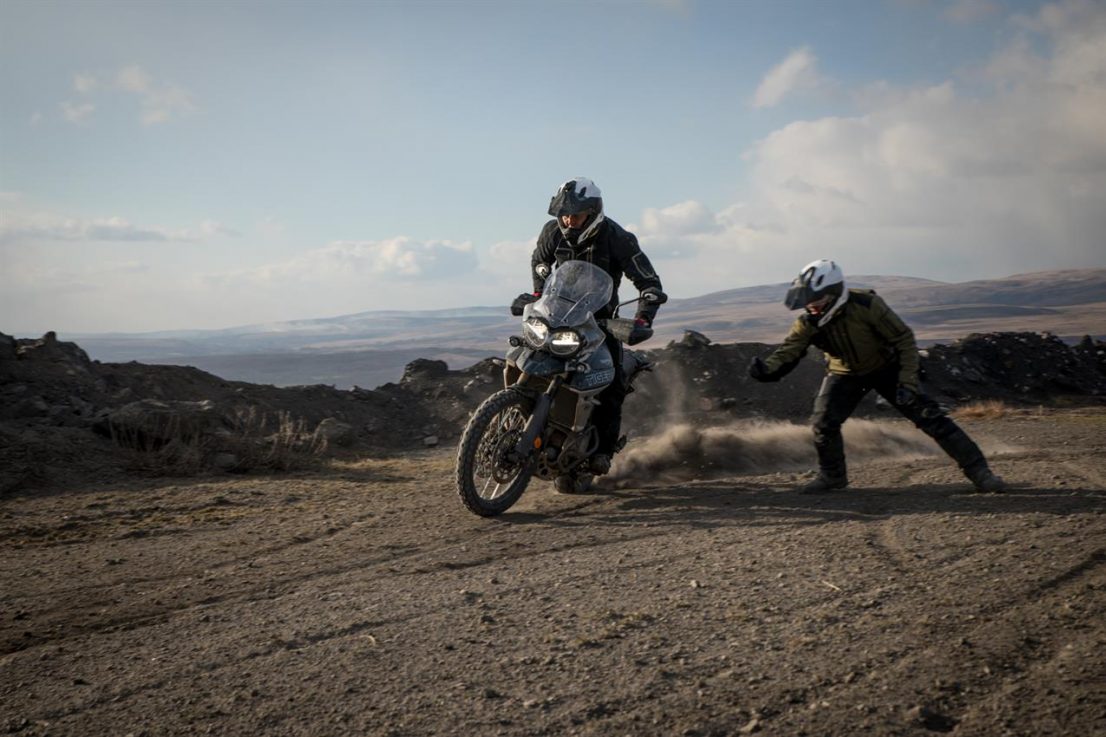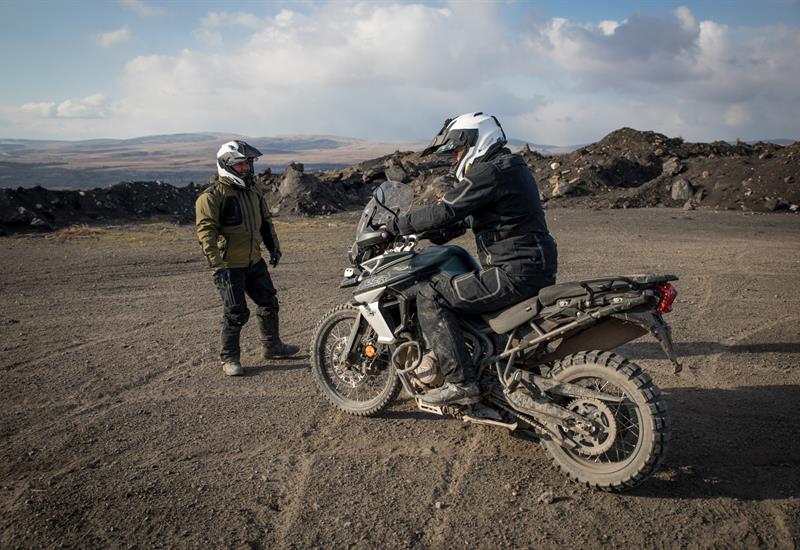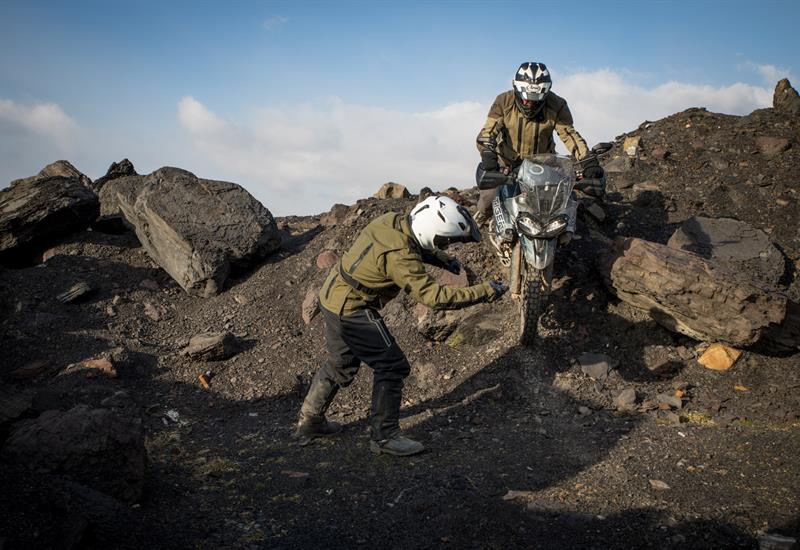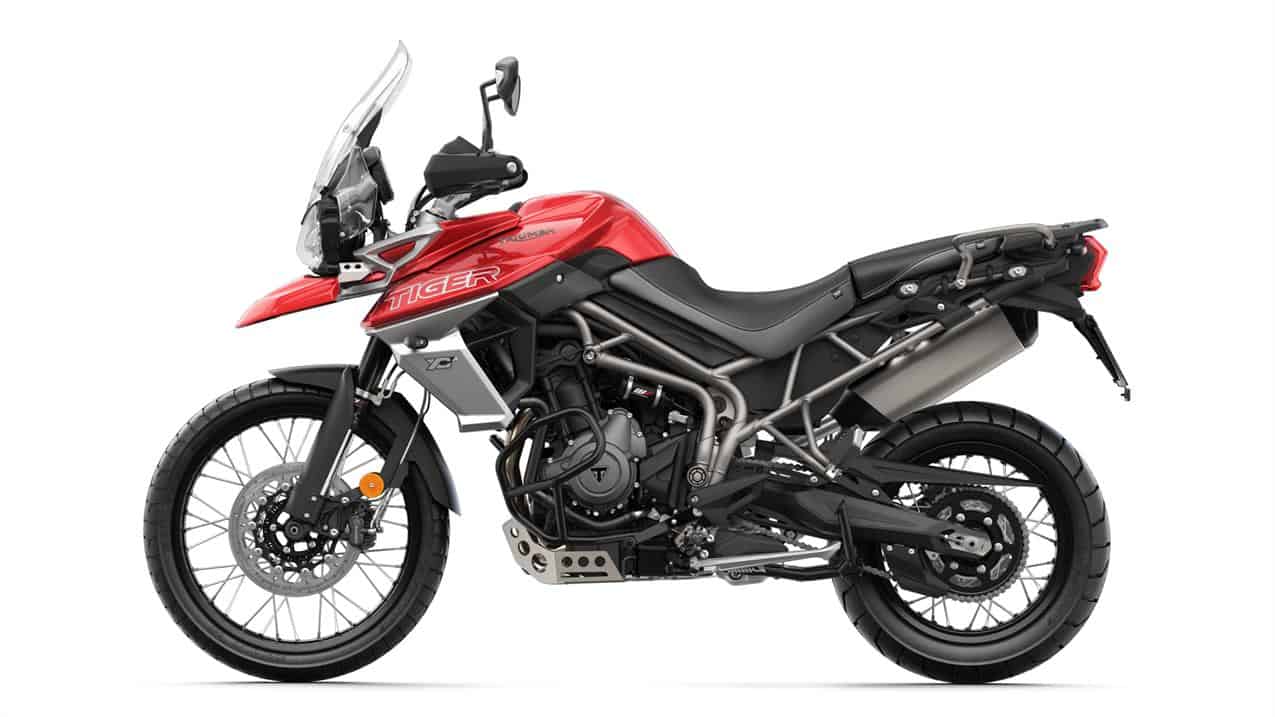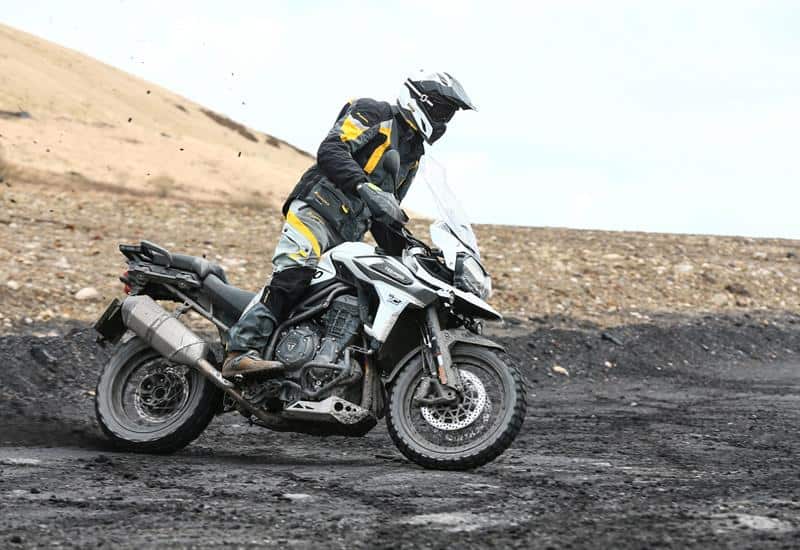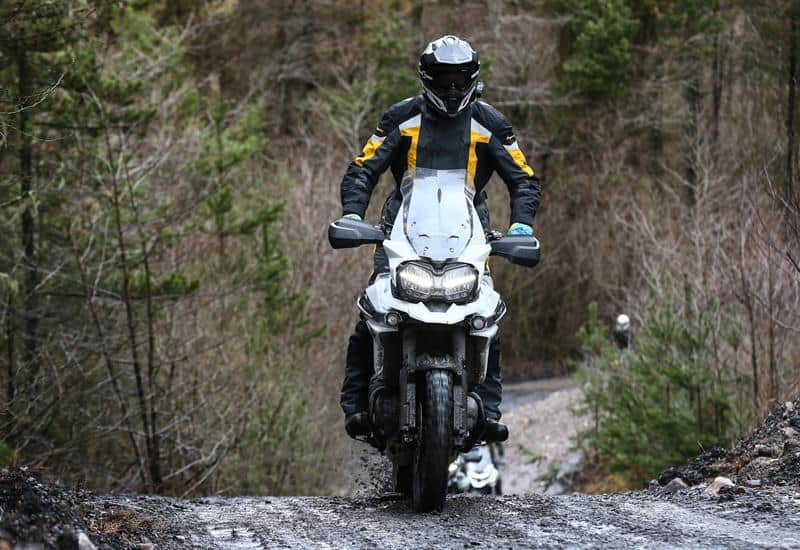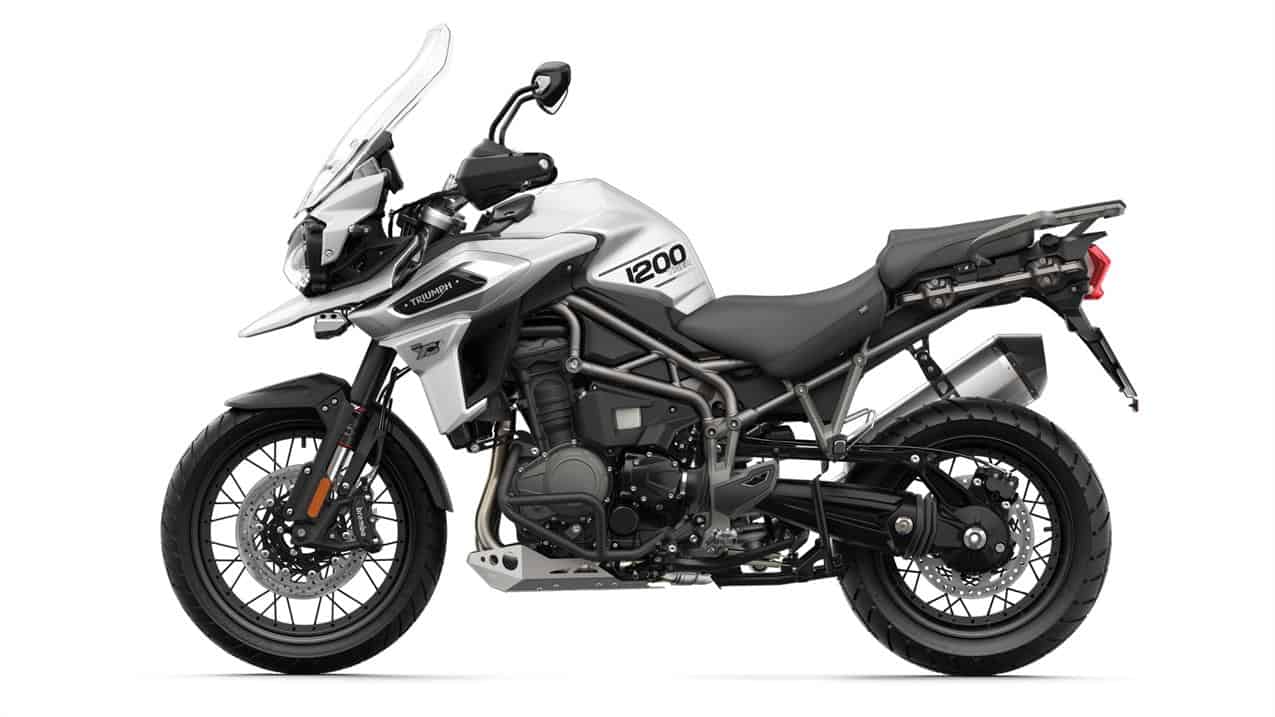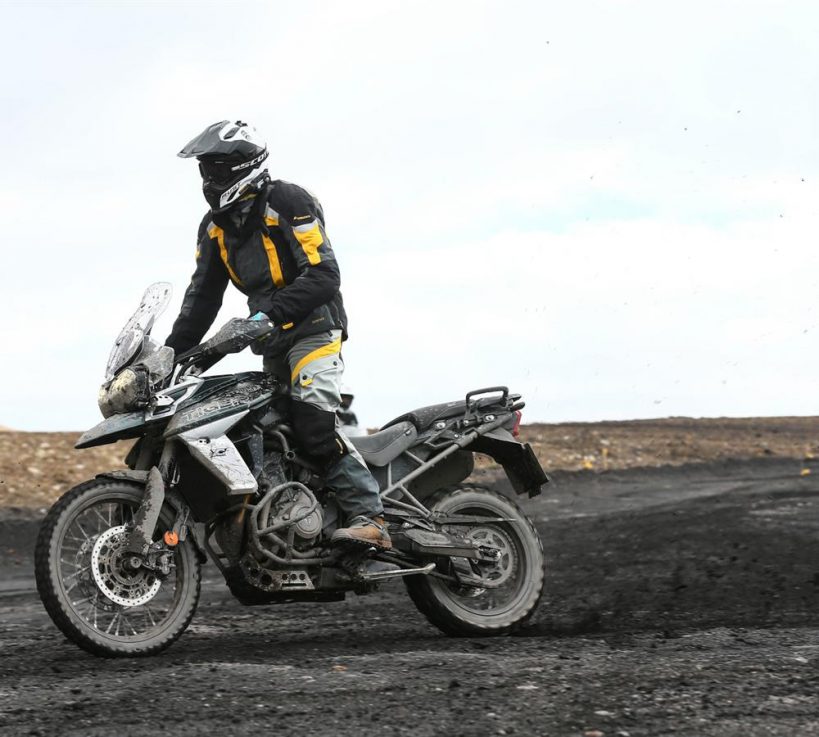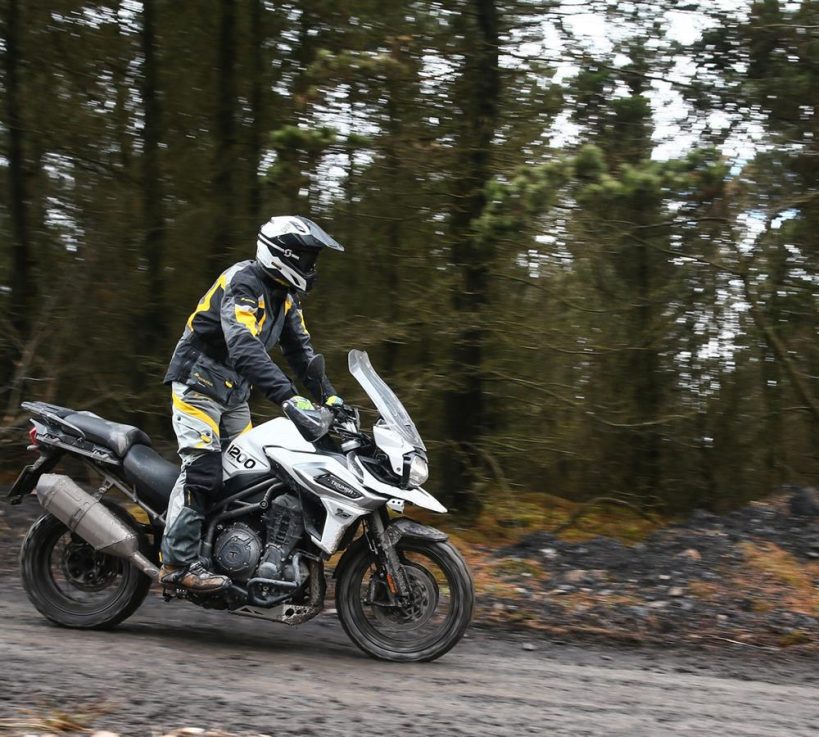I spin the Tiger 800XCa around in the mud, a classic lay-over skid about-turn centred around my planted left boot. I keep the gas on, the rear wheel spinning, and pile on the revs ever more as I ride up the slope (a zig). I reach a bank so chop the throttle, turn quickly and get back on the gas again (a zag). More wheel spin, but it’s controlled, I’m feet-up, in good balance. I crest the climb and with the rear wheel still spinning I scribe an arc as I head off to look for more challenges.
I’ve just ridden the XCa as I would an EXC. It’s a 200-kilo 95hp adventure bike, not an enduro. But it can do these things. And believe me, I’m no riding god.
2018 is a new year for Triumph, and especially for their adventure fleet. The Tiger 800s and Tiger 1200s (the bigger models are no longer called Explorers) have received hundreds of upgrades between them and given the launch of the Triumph Adventure Experience in Wales – the first of several such centres planned for around the world – you can tell Triumph are putting ever-more impetus behind their adventure bikes. Oh, can we call an 800 and a 1200 a ‘fleet’? Yes we can, because Triumph is producing a myriad of versions of each, with four road-biased types (XR, XRr, XRx and XRt) and two off-road-biased types (XCx and XCa) in each capacity, so that’s 12 options in all. Of course this being RUST it’s the XC models we’re interested in.
TIGER 800
The new Tiger 800 doesn’t look so new. That’s on first impressions. After all, the engine – that distinctive 800cc triple – hasn’t externally (or internally) changed much since the launch of the model in 2010. Neither has the chassis, it’s still a steel trellis type. And the bodywork looks much the same. All of which is good news for owners of the older Tiger 800s – their bikes haven’t dated so much, don’t look obsolete, and probably as a consequence are holding their values well. But it also means you don’t quite get the visual excitement a new model usually creates. Only the looks flatter to deceive, in fact much has changed, and it’s all in the detail, of course.
It’s worth stepping back in time before going forwards, though. When the Tiger 800 was updated in 2015 a lot was improved. The WP suspension was a big upgrade and for the XCx/a variants that made a big difference in off-road capability. That model also got a fly-by-wire throttle and traction control, making overall ride-ability that bit nicer, while fuel efficiency improved by a claimed 17%. All very handy, and all helped make the Tiger 800 super-serious competition for BMW’s F800GS. In many ways it was better, feeling to be marginally lower in the saddle and more alive off-road. The BMW has indestructible tank-like solidity to it, but the Triumph wins for dynamics.
The 2018 model brings a reputed 200 improvements, but Triumph aren’t listing them all, instead just hitting their top-10, as it were. So while this is in effect the third generation of Tiger 800s, just as in 2015 we’re talking evolution, not revolution.
Rider aids seems to be where we are at. Triumph leadoff with their new 5” (adjustable for angle) TFT instrument panel. TFT, FYI, stands for Thin Film Transistor, its common in modern televisions too. It’s a full colour unit that allows six options on displays, complete with scrolling menus (for rider modes etc) and auto-adjustment on brightness according to light conditions. It’s very easy to take this unit for granted – smartphone technology has raised our expectations on anything electronic – but it’s a long way from the analogue tacho-speedo-tripmeter instruments of our not-so-distant past. And of course it makes the selection of the various rider aids that much easier to make. In fact it was entirely necessary so as to be able to make the personalisations you can now choose from in the Rider Programmable mode.
Allied to this unit are the new backlit (for night riding) switch blocks on the handlebars, and particularly the five-way joystick that’s the main navigator for the rider aid functions. We should quickly rattle off the next bits: all LED-lighting (brighter, improved visibility benefits), five-way adjustable screen (single hand operation – not electronic), updated Brembo brakes and updated cruise control.
Arguably the biggest update is in the rider modes, which for the XCs offer Road, Rain, Sport, Off-Road and Off-Road Pro. And for the top-of-the-line XCa there’s a sixth: Rider Programmable. This one’s the trick option as it allows you to personalize the effects of the ABS, traction control, throttle mapping etc. Off-Road Pro seems to translate to ‘Everything Off’ – hence ‘Pro’ – so here at RUST we like the programmable mode best as our experience suggests degrees of ABS and traction control never go amiss, especially where full electronic intervention can lead to frustration, while zero intervention can lead to crashes.
Together with some styling tweaks, quite a few changes to the frame (so we’re told) and few other details (like a shorter first gear) we end up with over 200 upgrades. But bore/stroke, brake horsepower – yeah, as before.
WHAT’S IT LIKE?
On-Road
On road it’s surprising how little you notice the gangly 21” front wheel. That’s a skinny 90/90-21 hoop up front, but it feels secure and having the ABS there to step-in if you overdo the braking is a great advantage. The handling on road is then very predictable and secure, in the wider scheme of things the Tiger 800 is a tall bike but it doesn’t teeter and while its no road racer, on the roads you’re not feeling as compromised as you might think.
The performance from the motor is nothing short of impressive. In Road mode it’s a very comfortable easy-going companion that lets you cruise along with minimum of attention to operations. In Rain mode by heck its strangled – probably to A2 licence limits or more – ideal for nervous types but a bit too much for some of us gung-ho types even in the wet. Sport mode has more than a dash of Moto2 to it; it’s represented by a Stig-like helmet icon on the dash, and it unleashes the full potential of the motor – the Tiger rockets away, to a wailing-howling soundtrack that’s pure grand prix. It’s like no adventure bike we’ve ever met. And yes, we like this aspect, a lot. Adventure bikes are about taking it easy, seeing the world, but even adventure riders like to let off steam sometime.
Comfort is very good. It’s a comfortable saddle, the pillion isn’t sold short, and there’s enough room to stretch limbs and for taller folk there’s a higher-seat position that works. The heated grips are great and are hot when on full power (especially if wearing thin motocross type gloves). There’s a heated seat, too – such luxuries! Long days (and with a tank range easily over 250 miles you can have very long days) will not be an issue.
Off-Road
You want to say it doesn’t deserve to be as good as it is. Because no one ever thought an 800cc triple should make a dirt bike. But it does deserve to be this good, because Triumph’s engineers clearly have worked bloody hard to make it so.
The power characteristics in Off-Road and Off-Road Pro modes certainly suit dirt riding. There’s snap enough to lighten the front in an instant, but not so much that you get unintended wheelspin. That low first gear works great and the whole gearbox shifts just fine. In all you can forget structuring your input and simply ride on instinct – as you should. Only in the slipperiest going do you think harder and feel more.
The chassis works great, too. The WP suspension is lovely stuff, it feels firm but is fairly plush and rides mostly high, so you’re not riding low and saggy. The Showa kit on the very first Tiger 800s was a let down, but the Triumph engineers have clearly worked hard on this aspect and this helps the Tiger to ride confidently and assured into almost any terrain. The fussy-man in me would argue that the set-up could be even plusher, but we’re talking almost bespoke levels here. Allied to this, those Brembo brakes offer feel and just about the right amount of strength for off-road; backed-up by the excellent adjustable ABS you can fine tune the responses there as well.
The standing riding position is very good. It’s probably excellent for those 5’10” or shorter, but being 6’0” for me it was probably 10mm of bar riser away from being spot on. The 19-litre fuel tank is broad across the front but it narrows perfectly toward the rear to allow comfortable standing and is good to lean against when you want to load up the front end. Likewise the footpegs aren’t too far forward – ideally placed. With the wide-ish handlebars, in all you get very close to what feels like an authentic dirt bike riding position.
Overall
Let it be said I like BMWs, but the Tiger really does knock the spots off the F800GS. There is no competition in my mind as to which of these I prefer to ride. On virtually every point of comparison the Tiger feels superior and the clincher (after the great on-road engine performance) is the great level of confidence it instills when ridden off-road. This is a bike you trust, implicitly. It is, I feel sure, because of this bike that BMW had to develop the 850GS. They needed to anyway, because the 800GS was never quite right, but the Tiger made sure they worked all the harder. How good the 850GS is remains to be seen and first reports from the world launch (hey, where was our invite?!) aren’t entirely favourable so the new GS really does have its work cut out if it’s to match this latest and greatest Tiger.
Ah, an unfortunate last word (in fact a number): £12,450 (for the XCa) in the UK. Boy, that is not cheap (the opposite). But this is 2018, check out the list RRP on all manner of things, but cars and bikes especially – costs of production worldwide are escalating. It’s going to need some recalibration for us to get used to that.
TIGER 1200
Having been significantly updated as recently as 2016, the Tiger 1200’s list of updates is about half that of the Tiger 800’s, ‘up to 100’ say Triumph. Again they don’t detail every last one (we’ll take their word) instead listing a very similar top-10.
Big news for 2018 is a 10kg weight saving. That’s good news, but Triumph’s 1200 has always been the woolly mammoth of adventure bikes, so even 10kg still leaves it short of the competition. Yeah, 248kg dry compares to 244kg wet for a BMW R 1200 GS – don’t stop with the Slimfast Plan just yet, Tiger…
Again many of the upgrades and refinements are electronic rider-aid biased, so we again see a TFT screen for the instruments, LED lights, backlit switchgear, Off-Road Pro (and programmable) rider mode. Add to that adaptive cornering lighting, shift assist for the gearbox and keyless ignition, along with existing aids like hill hold and cornering ABS.
The big fat Tiger has a sharper look this year, though. Maybe still not as sharp as the competition – forget ‘maybe’, it’s just not – but its another improvement at least. And when you’re sat in the super-satisfying heated seat with heated grips behind an electronically adjustable screen (on a cold day) maybe sharp looks don’t matter so much.
WHAT’S IT LIKE?
On Road
Big, smooth, quiet, assured, comfortable. On road the Tiger 1200 feels like a regular big-capacity tourer. In fact it almost matches dedicated the road tourers for comfort and equipment, so on this account there should be zero criticism. Yeah, there are sufficient whistles and bells to keep a tech-head fully occupied, while ample saddles will keep even the broadest of rumps comfortable.
The Tiger 1200 produces a good 15hp more than the BMW R 1200 GS and you can hear that extra go in the engine and exhaust noise when you hit WFO – the beast rips. But where the Tiger 800 is a fighter plane the Tiger 1200 is more bomber – impressive, but don’t get too carried away, eh chaps? Again it impresses, and comfort is a major ace card, so long distance work is a doddle.
Off-Road
It’s not a big fat Tiger. It’s THE big fat Tiger. Ever since I got to ride a 2014 Tiger 1200 deep into the Madagascan bush (back in 2016) I’ve known the Tiger has better dirt credentials than most care to credit it. That bike followed a KTM 1190 Adventure and BMW R1200 GS everywhere, was never left behind, and when we got to deep sand – you may not believe this – it killed them both. The Tiger loved the sand, revved hard and ridden with marginal self-preservation it was quite the weapon.
And the 2018 Tiger 1200 is someway advanced from that first generation model. It doesn’t feel as tall, nor as top heavy and the power feels strong everywhere. The ride position feels a lot better sorted, too, it’s very natural and so despite being the size it is you can still boss it. Just like all those countless self-gratifying Facebook and YouTube clips of guys skidding their GSs in ever more daring displays, you can play silly-buggers on the Tiger, too.
As with the earlier model the only place it feels to let you down is in slow first-gear slippery going, where the 141hp can come in just a little too abruptly prompting wheelspin. But even that we found we could sort. In the rider programmable mode we combined an off road pro setting with a rain setting on the engine map. This combined with the new low first gear brought decent traction. Job done!
Big mention again here for the WP suspension. On the Tiger 1200 it’s a semi-active set-up and it works so well, feeling plusher, easier on the rider than that of the 800. There’s no jarring and even when we did some cheeky hops off banks and bumps there’s no crashing through the stroke. This is quality kit and for sure helps the big Tiger be as assured and light on its feet as it is.
If anything the Tiger 1200 sells itself better off-road than on. It’s more impressive and its capabilities defy belief. And that makes it all the more satisfying. Of course we’re stopping short of saying it’s better than a 1200 GS or a KTM 1290 Super Adventure, but it’s so much closer than you think.
Overall
Can the Tiger 1200 beat a 1200 GS? Maybe, maybe not. The GS is still the benchmark, still has all that history. But the Triumph engineers are evidently tireless workers, they’re looking to their own premium measures and so there’s no question this is a great bike. We love the Tiger 800, but riding the Tiger 1200 off-road is a special thrill, so much so that on the (test) day we spent more time riding the 1200, exploring its limits (much further off than you’d think). And so while as a road bike it’s very good, it’s as dirt roads adventurer that this bike has us coming back for more, again and again. Yep, like we said, it’s not a big fat Tiger. It’s THE big fat Tiger. Skidoosh!
THE WRAP
Boy, has Triumph come out swinging in 2018. The new Tiger 800 is solid gold – such the natural performer off-road, yet so very much a road bike on the tarmac – somebody show me where the compromise came, I can’t see it? And it’s so darn characterful, so darn good. Triumph have taken a seriously good model and made it even better. It stands to become the market benchmark. And it’s a triple?! Woah. The Tiger 1200 is another case of making the impossible possible. You hear how the pilots of these new super-airliners (Airbus A380, Boeing Dreamliner etc) tell of the pussycat handling of these new-era super planes – well, the Tiger 1200 must have some of that stuff. So big and yet so useable – off road… Bigger is better! In all a vintage year for Triumph adventure, for sure.
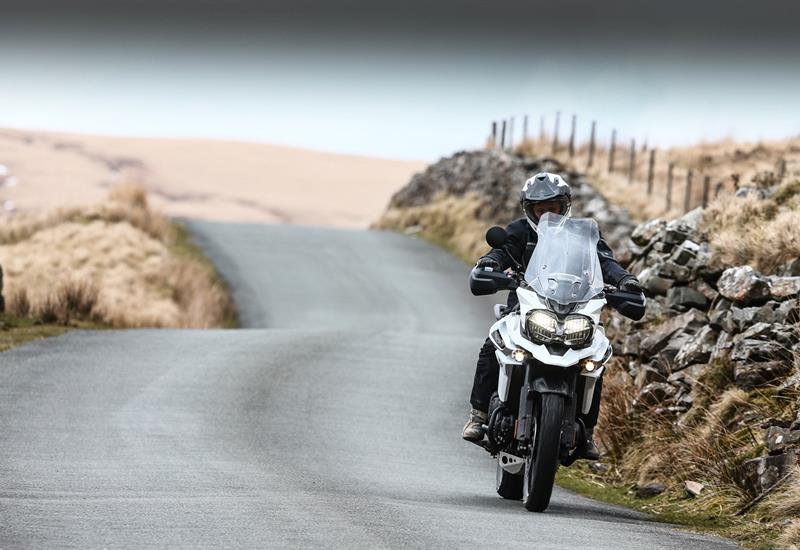
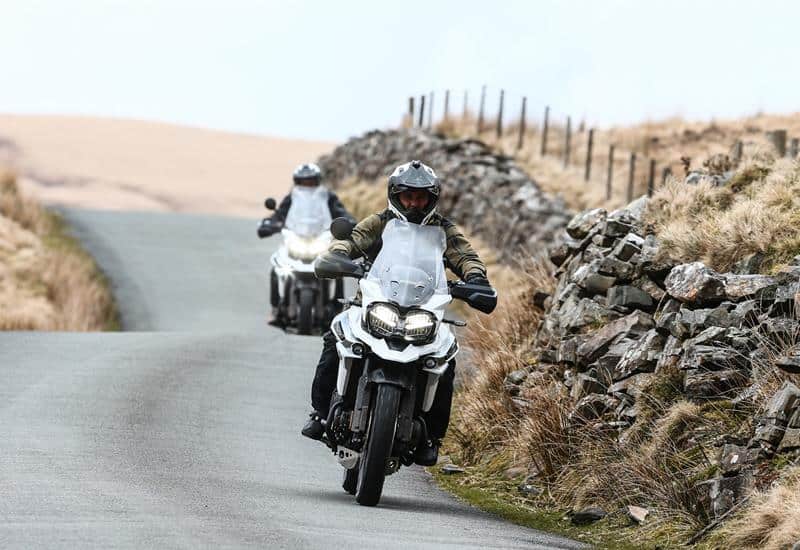
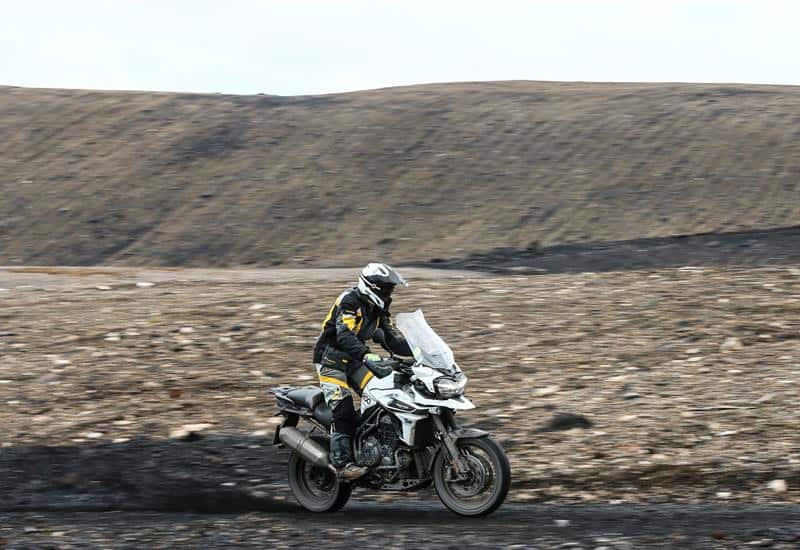
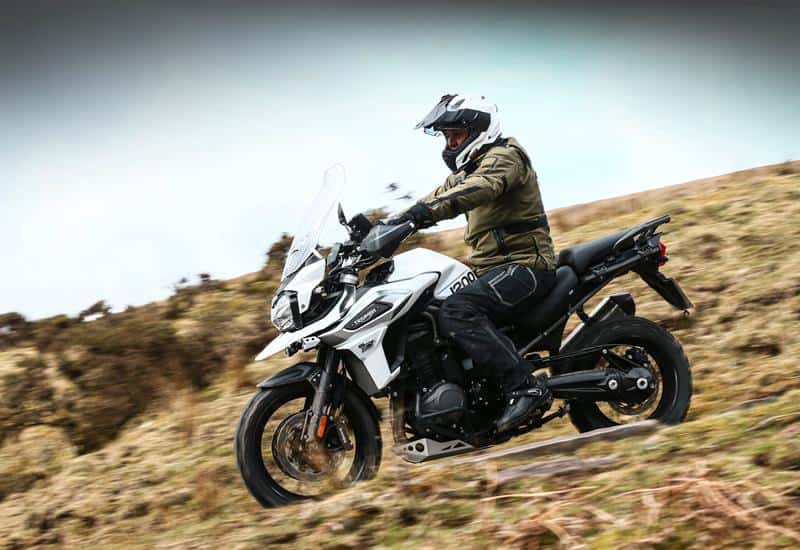
TRIUMPH Tiger 800XCa
Specifications
Engine: Liquid cooled DOHC 12-valve in-line three cylinder four-stroke
Displacement: 800cc
Bore & stroke: 74.05 x 61.9mm
Max Power: 70kW (95bhp) @ 9500rpm
Max Torque: 79Nm (58lb.ft) @ 8050rpm
Fueling: EFI
Starter: Electric
Transmission: Six-speed gearbox, wet multiplate clutch
Frame: Tubular steel trellis
Front suspension: WP 43mm USD forks adj for compression and rebound, 220mm travel
Rear suspension: WP monoshock, hydraulically adjustable preload, 215mm travel
Tyres: 90/90-21, 150/70-17 (Pirelli Scorpion Rally fitted for the test)
Wheels: wire-laced spoked wheels
Brakes: Front disc 305mm Brembo twin-piston caliper, Rear disc 255mm, single piston Nissin caliper, switchable ABS
Seat height: 840-860mm
Wheelbase: 1545mm
Weight: 208kg (dry)
Fuel capacity: 19 l
Colours: korosi red / crystal white / marine
Contact: www.triumphmotorcycles.co.uk
UK price: £12,450
US price: $8699
TRIUMPH Tiger 1200 XCa
Specifications
Engine: Liquid-cooled DOHC 12 valve, in-line three-cylinder four-stroke
Displacement: 1215cc
Bore & stroke: 85.0 x 71.4mm
Max Power: 104kW (141bhp) @ 9350rpm
Max Torque: 122Nm (90lb.ft) @ 7600rpm
Fueling: EFI
Starter: Electric
Transmission: Six-speed gearbox, wet multiplate clutch
Frame: Tubular steel trellis frame
Front suspension: WP 48mm USD forks (electronically adjustable damping), 190mm travel
Rear suspension: WP monoshock (semi-active), electronically adjustable preload 193mm travel
Tyres: 120/70-19 170/60-17 (tubeless Pirelli Scorpion Rally for the test)
Wheels: wire-laced spoked wheels
Brakes: Front disc 305mm, Brembo four-piston radially mounted caliper – Rear disc 282mm, Nissin twin-piston caliper, switchable ABS
Seat height: 835-855mm
Wheelbase: 1520mm
Weight: 248kg (dry)
Fuel capacity: 20 l
Colours: marine / crystal white
Contact: www.triumphmotorcycles.co.uk
UK price: £16,950
US price: $21,750

